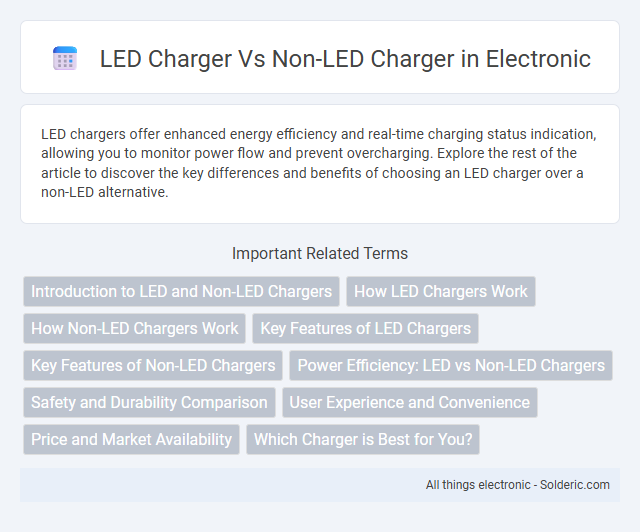LED chargers offer enhanced energy efficiency and real-time charging status indication, allowing you to monitor power flow and prevent overcharging. Explore the rest of the article to discover the key differences and benefits of choosing an LED charger over a non-LED alternative.
Comparison Table
| Feature | LED Charger | Non-LED Charger |
|---|---|---|
| Indicator Light | Yes, LED shows charging status | No visual indicator |
| Energy Efficiency | Typically higher due to technology | Standard efficiency |
| Charging Speed | Often faster with optimized circuitry | Standard charging speed |
| Durability | Usually longer lifespan due to LED technology | Varies, potentially shorter lifespan |
| User Convenience | Easy status monitoring via LED | Lacks real-time charging feedback |
| Cost | Generally higher price | Lower price |
Introduction to LED and Non-LED Chargers
LED chargers incorporate light-emitting diodes as indicators for charging status, enhancing user convenience by providing visual feedback on power flow and battery level. Non-LED chargers lack these visual indicators, making it harder to determine charging progress without external monitoring. The integration of LED technology in chargers improves usability and safety by signaling operational states such as full charge or fault conditions.
How LED Chargers Work
LED chargers use light-emitting diodes to indicate charging status by emitting different colors or blinking patterns, providing visual feedback on battery level and charging progress. These chargers often incorporate smart circuitry that controls power flow efficiently, preventing overcharging and enhancing battery lifespan. You can easily monitor your device's charging state with an LED charger, which improves convenience compared to non-LED models that lack such indicators.
How Non-LED Chargers Work
Non-LED chargers operate by converting AC power into DC power through internal components like transformers, rectifiers, and voltage regulators without emitting visible indicators such as lights. These chargers rely on internal circuitry to maintain stable voltage output, ensuring device safety and efficiency during charging. While non-LED chargers lack visual feedback, their performance in delivering consistent power to your device remains effective.
Key Features of LED Chargers
LED chargers provide real-time charging status through bright indicator lights, allowing you to easily monitor your device's power level and avoid overcharging. They often feature enhanced energy efficiency and lower heat emission compared to non-LED chargers, which improves battery lifespan and safety. Your charging experience becomes more reliable with built-in smart technology that adjusts power delivery based on the device's needs in LED chargers.
Key Features of Non-LED Chargers
Non-LED chargers typically feature straightforward designs with basic charging capabilities, lacking advanced visual indicators for power or charging status. These chargers often support standard voltage outputs and may include built-in safety mechanisms such as overcharge and short-circuit protection without digital feedback. Your device may rely on external cues or manual checks to confirm charging progress due to the absence of LED indicators.
Power Efficiency: LED vs Non-LED Chargers
LED chargers typically offer higher power efficiency compared to non-LED chargers due to their advanced circuitry and lower energy dissipation. Your devices benefit from faster charging times and reduced electricity consumption with LED chargers, making them a more eco-friendly and cost-effective choice. Non-LED chargers often lose more power as heat, resulting in inefficient energy use and slower charging performance.
Safety and Durability Comparison
LED chargers often provide enhanced safety features such as overcharge protection, short-circuit prevention, and temperature regulation, reducing the risk of electrical hazards compared to non-LED chargers. The visible LED indicators help users monitor charging status, preventing battery damage from overcharging or overheating. Non-LED chargers may lack immediate feedback mechanisms, potentially compromising durability and increasing the likelihood of device wear or failure over time.
User Experience and Convenience
LED chargers enhance user experience by providing clear visual indicators of charging status, allowing you to easily monitor progress without guessing. Non-LED chargers lack this feature, often causing uncertainty and inconvenience during use. The convenience of an LED charger reduces the risk of overcharging and improves overall device management.
Price and Market Availability
LED chargers generally have a higher price point due to the additional components and technology required for LED indicators. Market availability of LED chargers is growing rapidly as consumer demand increases for more user-friendly, visually informative charging devices. Non-LED chargers remain widely available and more affordable, appealing to budget-conscious buyers and basic charging needs.
Which Charger is Best for You?
LED chargers offer real-time charging status indicators, enhancing convenience and preventing overcharging by showing when your device is fully powered. Non-LED chargers typically lack these visual cues, which might lead to less efficient charging habits or potential battery wear over time. Your choice depends on whether you prioritize clear charging feedback and energy efficiency, making LED chargers often the better option for modern devices.
LED charger vs non-LED charger Infographic

 solderic.com
solderic.com